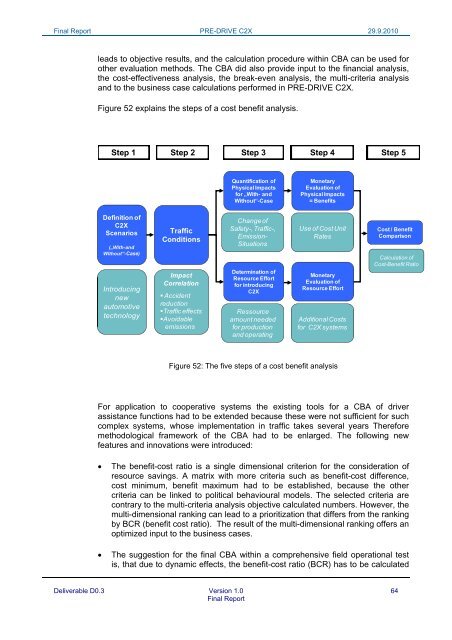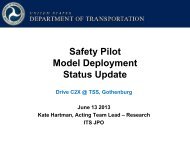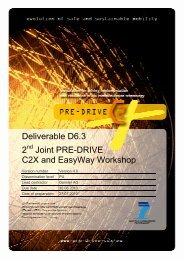PRE-DRIVE C2X Deliverable D0.3 Final report_20100929.pdf
PRE-DRIVE C2X Deliverable D0.3 Final report_20100929.pdf
PRE-DRIVE C2X Deliverable D0.3 Final report_20100929.pdf
You also want an ePaper? Increase the reach of your titles
YUMPU automatically turns print PDFs into web optimized ePapers that Google loves.
<strong>Final</strong> Report <strong>PRE</strong>-<strong>DRIVE</strong> <strong>C2X</strong> 29.9.2010<br />
leads to objective results, and the calculation procedure within CBA can be used for<br />
other evaluation methods. The CBA did also provide input to the financial analysis,<br />
the cost-effectiveness analysis, the break-even analysis, the multi-criteria analysis<br />
and to the business case calculations performed in <strong>PRE</strong>-<strong>DRIVE</strong> <strong>C2X</strong>.<br />
Figure 52 explains the steps of a cost benefit analysis.<br />
Step 1 Step 2<br />
Step 3 Step 4 Step 5<br />
Quantification of<br />
Physical Impacts<br />
for „With- and<br />
Without“-Case<br />
Monetary<br />
Evaluation of<br />
Physical Impacts<br />
= Benefits<br />
Definition of<br />
<strong>C2X</strong><br />
Scenarios<br />
(„With-and<br />
Without“-Case)<br />
Introducing<br />
new<br />
automotive<br />
technology<br />
Traffic<br />
Conditions<br />
Impact<br />
Correlation<br />
• Accident<br />
reduction<br />
•Traffic effects<br />
•Avoidable<br />
emissions<br />
Change of<br />
Safety-, Traffic-,<br />
Emission-<br />
Situations<br />
Determination of<br />
Resource Effort<br />
for introducing<br />
<strong>C2X</strong><br />
Ressource<br />
amount needed<br />
for production<br />
and operating<br />
Use of Cost Unit<br />
Rates<br />
Monetary<br />
Evaluation of<br />
Resource Effort<br />
Additional Costs<br />
for <strong>C2X</strong> systems<br />
Cost / Benefit<br />
Comparison<br />
Calculation of<br />
Cost-Benefit Ratio<br />
Figure 52: The five steps of a cost benefit analysis<br />
For application to cooperative systems the existing tools for a CBA of driver<br />
assistance functions had to be extended because these were not sufficient for such<br />
complex systems, whose implementation in traffic takes several years Therefore<br />
methodological framework of the CBA had to be enlarged. The following new<br />
features and innovations were introduced:<br />
<br />
<br />
The benefit-cost ratio is a single dimensional criterion for the consideration of<br />
resource savings. A matrix with more criteria such as benefit-cost difference,<br />
cost minimum, benefit maximum had to be established, because the other<br />
criteria can be linked to political behavioural models. The selected criteria are<br />
contrary to the multi-criteria analysis objective calculated numbers. However, the<br />
multi-dimensional ranking can lead to a prioritization that differs from the ranking<br />
by BCR (benefit cost ratio). The result of the multi-dimensional ranking offers an<br />
optimized input to the business cases.<br />
The suggestion for the final CBA within a comprehensive field operational test<br />
is, that due to dynamic effects, the benefit-cost ratio (BCR) has to be calculated<br />
<strong>Deliverable</strong> <strong>D0.3</strong> Version 1.0 64<br />
<strong>Final</strong> Report







